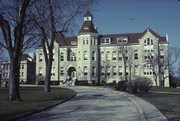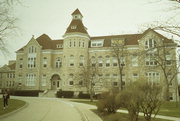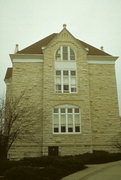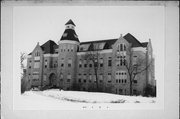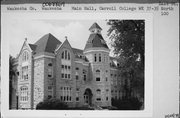| Additional Information: | "Old Main" replaced an early Main Hall (1853) which was destroyed by fire in 1885. The design of the present building (with the exception of the north wing), was created by Stephen Shipman , of Chicago. The cornerstone was laid in 1885 and the building was dedicated in 1887. Main Hall was constructed of the beautiful native stone, quarried west of Carroll College. The design of the building is eclectic with overtones of Richardsonian Romanesque evident in massing and individual details. The main building rises two stories from basement to eave line. Pavilions and polygonal tower rise an additional floor. Dominating the facade is the polygonal tower which is capped by a sectional roof, culminating in a cupola. Pointed arches cover first and second story windows in the tower, narrow round headed windows occupy the third level. Adjoining the tower is the main entrance, recessed beneath a heavy Romanesque arch. A variety of textural patterns accent the building, ranging from the rusticated stone of the walls to smooth, carved window surrounds and square block belt courses on the tower.
Main Hall is an important visual landmark, situated on a hill south of the main commercial area of Waukesha. The large scale of the building, as well as the high quality masonry work contribute to its importance.
Carroll College was chartered by the Wisconsin Territorial Legislature on January 31, 1846 and was the first college in the territory. As such it is of historic significance at the state level. The College developed from the earlier Prairieville Academy founded in June 1840. It was not the first such private school, however, as two others preceded it in the county. The names of both are lost to memory. The Academy was founded by William T. Bidwell, a teacher, and Lyman Goodnow, operator of the county's first limestone quarry. Bidwell wanted his own school and Goodnow wanted to show how well his stone worked as a building material. Morris Cutler donated two lots and a two story stone school was constructed, claimed by some to have been the first stone building in the state and first stone building in what became Waukesha. The Academy was officially incorporated on July 19, 1841. In 1844, the Academy collapsed financially and the property reverted to Cutler. Retaining the original charter, a new group which included local notables such as William A. Barstow, Alexander W. Randall, and Cutler, reconstituted the Academy under the direction of Professor Eleazur Root. His success convinced the Trustees to submit a new charter to the legislature elevating the academy to a college. The result was the charter granted to Carroll College on January 31, 1846. In 1848, Root was elected the State's first Superintendent of Public Instruction and his assistant, Professor John W. Sterling, became the first Professor of mathematics at the new University of Wisconsin and Carroll College was closed. At this point the paths of the Academy and the College separated. Stockholders of the original Academy had their charter restored but the Carroll Charter also remained intact. The Academy retained its building and tried to get it operating again with little success. The College was only a legal entity with no buildings, faculty, or students. In the fall of 1849, Professor Lucius Root (no relation) began holding preparatory courses in the then new basement of the First Presbyterian Church using the College Charter. In March 1850, the College was placed under the educational control of the Presbytery of Milwaukee and in September, John A. Savage of New York was appointed the first President of the College. Savage's role was largely that of fund raiser and classes continued in the church basement until 1853. In October of that year, the College proper re-opened and, with the preparatory school, shared a new two story stone building on a ten acre plot donated by Morris Cutler. The building was on the present site of Old Main. The College grew, graduating its first class of four in 1857; however, financial difficulties and the resignation of President Savage forced the closing of the college in 1860. Due to continued low finances and the Civil War, the college remained closed until 1866 when Walter L. Rankin became the second president, a post he retained until 1903. Rankin provided the leadership to make Carroll a stable institution. In 1866, he found himself President of a College without students, staff, or supporters, and a deteriorating building. The College began to grow once more but Rankin was unable to meet its debts or raise an endowment. He resigned in 1871, personally assuming half the institution's debt. Rankin returned in 1873 as Principal of the Carroll Academy, remaining until 1879 when the institution once again closed. Two years later he returned for the final time. The Academy survived and an endowment was finally created. In 1893, the College was once more able to open and has continued until the present. The present Old Main was built in 1885 when fire destroyed the 1853 building. In 1900, the College, assisted by benefactor Ralph Voorhees, constructed the north half of Main Hall to accomodate needed expansion. The building was named Voorhees Hall a that time but was later changed to Main Hall. |
|---|
| Bibliographic References: | (A) Langill, Ellen. Carroll College, The First Century, (Carroll College Waukesha, 1980).
(B) Butterfield, C.W., The History of Waukesha County, Wisconsin, Chicago, 1880, p. 436-437. |
|---|

